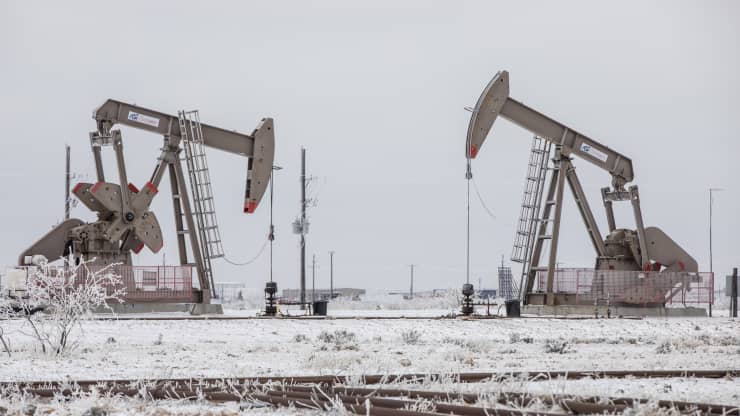When a raging snowstorm and frigid temperatures hit Texas last month, oil and gas behemoths responsible for producing and processing the lion share of the nation’s reserves, including Exxon, Occidental and Marathon Petroleum, shut down production at oil wells and refineries across the state.

For many oil producers in the Permian Basin of West Texas and New Mexico, the shutdown put upstream and downstream operations in a squeeze. Downstream, multiple refining operations flared during shutdowns, releasing air pollutants from processing units. Upstream, as oil drilling came back online, there was risk of needing to flare or halt oil production in the field until the broader energy market, including refining and utility generation, stabilized. Indeed, satellite imagery showed increased flaring at oil and gas production sites in the Permian Basin did take place, according to the Environmental Defense Fund.
But at Occidental, a choice was made to shut down some operations.
“There were a couple of plants that had difficulty coming back online,” Occidental’s CEO Vicki Hollub said during a recent CNBC Evolve event focused on energy innovation. “We could have put our production back online and just flared the gas. We chose not to do that. We left the production shut down because we didn’t want to flare.”
The decisions made during the Texas power crisis are part of a broader debate with the oil and gas industry over flaring, the process of releasing greenhouse gas emissions through burning, which has long been a controversial topic for environmental advocates and climate policy experts. The practice, which is commonly used by oil and gas companies to relieve the pressure that builds up during oil production, is responsible for releasing CO2 and methane into the atmosphere.
A more ambitious Big Oil goal
The flaring issue is a global one. According to the World Bank Group, global gas flares burn approximately 140 billion cubic meters of natural gas every year, emitting more than 300 million tons of CO2. Hundreds of companies, governments and oil corporations around the world have signed onto the organization’s Zero Routine Flaring by 2030 Initiative, which aims to eliminate all routine flaring within the next decade. While flaring is often used in cases where there’s safety concerns or maintenance issues, routine flaring means the flaring of gas associated with oil production.
Several big oil and gas companies including Occidental, Chevron and Shell have signed onto the pact. Zubin Bamji, program manager of the World Bank’s Global Gas Flaring Reduction Partnership, said reducing gas flaring is attainable for many of these companies and is a “low-hanging fruit” among other methods to reduce emissions.
Some experts say U.S. companies, specifically, need a more ambitious goal toward stopping routine flaring. The World Bank agreement focuses predominantly on reducing emissions in countries lacking the regulatory capacity and the infrastructure, but some experts say U.S. companies can accomplish the feat by 2025.
“Here in Texas, we’re talking about a 100-year-old basin,” said Colin Leyden, the director of regulatory and legislative affairs the Environmental Defense Fund. “2030 works on the global framework, but it lacks ambition domestically here in the U.S.”
But flaring often remains a cheaper alternative to pushing the gas to market, and flaring often comes down to the fundamentals of supply and demand.
Alternatives to flaring
The process of halting routine flaring, by methods such as rewiring gas for electricity or internal uses, isn’t difficult in and of itself, says Gunnar Schade, an atmospheric scientist and associate professor at Texas A&M University who has written extensively on the topic. The technology is there, it’s a question of whether the companies want to make the investment and put in the money.
Occidental’s New Mexico operations now use a gas gathering system linked to third-party capacity and pipeline supply arrangements which it says reduced 2019 annual carbon dioxide equivalent (CO2e) flaring emissions by more than 60% versus what would have been emitted otherwise, and that can be used in other upstream oil and gas projects to reduce flaring, the company said in an annual climate report.
As one recent report on flaring stated, “If most associated gas goes to sales, the dilemma about how to manage it becomes largely moot.”
Getting natural gas out of the Permian Basin to market is the preferred solution of the industry, but the natural gas market has been marked by oversupply and low prices for years, and for many companies, the economic analysis does not favor a major change in current operations.
There are onsite solutions that could become scalable. Some alternatives include building pipelines to pump gas back into businesses for heat and electricity, or the implementation of vapor recovery units which can collect vapors and reduce emissions.
“The important thing to realize here is that stopping entails investments because flaring is free, you don’t have to pay anything for it, the atmosphere is a free sewer,” Schade said.
Renewed focus on climate change
If natural gas prices were higher on a consistent basis, the flaring issue would not be as significant, Leyden says, but with a long-term, low-price outlook for natural gas, a new regulatory framework to realign incentives is needed.
Flaring is currently legal, meaning regulatory policies that encourage using gas for other purposes are required. Some states are making progress. New Mexico recently began debating a bill to manage flaring and venting, while advocacy groups and legislatures in Texas are slated to debate two bills which target the practice, one of which would put a 25% tax on gas vented or flared while extracting oil.
Typically, flaring involves burning off the gas atop a large tower or stack. It’s often used when oil companies lack facilities or markets available for the leftover gas. While the practice may be more environmentally friendly than venting, a process which releases natural gas straight into the atmosphere, it’s still a key source of methane, CO2 and emissions of other problematic compounds which can have drastic effects on human health.
Technological advancements over the years have streamlined the process of flaring and its efficiency, but organizations still say the practice is responsible for a large portion of emissions. According to data from The World Bank, between 2014 and 2018, the United States ranked among the top five flaring countries globally, behind Russia, Iraq and Iran.
In recent years, oil giants have increased focus on emissions reduction, including Exxon, which plans to cut methane emissions by 40% to 50% and flaring by 35% to 45% by 2025. British oil giant BP and Royal Dutch Shell outlined plans toward net zero emissions by 2050. An end to routine flaring is part of these commitments, but the companies need to take the expensive steps now to reengineer their operations.
“There are a lot of different options out there, but the problem is they all come with a cost,” Leyden said. “As long as flaring is an option because of a loose regulatory framework, it’s going to be difficult for these options to catch on.”
Occidental was the first U.S. oil company to sign onto the World Bank no flaring policy by 2030.
Texas energy crisis and new policy
Amid the Texas crisis, companies struggled to procure sources of power generations like natural gas, yet at the same time, companies continued to burn it off as natural gas and electricity prices rose, an issue that left some consumers and industry critics dumbfounded.
“I can tell you, we have flared in the past, we also have to flare sometimes when third party plants go down, but what we’re trying best to do is minimize that,” Hollub said at the recent CNBC Evolve event.
Many oil and gas companies like Occidental are more sensitive to the environmental issues at the forefront of investor efforts. The world’s largest money manager, BlackRock, will require companies it invests in to disclose direct emissions. Earlier this year, President Biden rejoined the Paris Climate Agreement, calling on agencies to review and reinstate regulations dismissed under the Trump administration.
“I would much rather have us, business, do it ourselves and that’s one of my big cries out in this letter: we need to do it ourselves before the government does it for us,” said BlackRock CEO Larry Fink in a CNBC interview earlier this year after releasing the company’s 2021 letter to CEOs, which called for more climate change disclosure from companies.
“We’ve had a lack of oversight on oil and gas,” Leyden said.
The Railroad Commission of Texas, which has jurisdiction over the industry’s operations but has not in the past cracked down on it, has recently moved to take a closer look as investors and legislators place more attention on the issue. The recent energy crisis could be a turning point for the self-regulation approach in the state.
“The large amounts of flaring are a microcosm of what can result from self regulation,” Leyden said. “The investment community is lining up around 2025. It has to happen rapidly. 2030, that’s a decade out and this is one of the easier things they can do from a policy standpoint.”
The scale of flaring in the Permian is significant. New markets — and costs such as taxes on flaring or strict permitting requirements for new wells — could incentivize companies to see the economics of flaring differently, combined with the investor focus on ESG.
“If you have a policy that says we won’t tolerate routine flaring, that you can’t bring an oil well online, can’t start pumping until you have destination for the gas, that will change the economics around midstream as well and increase the need to invest in the infrastructure,” Leyden said.
A 2019 analysis from the Baker Institute at Rice University noted that if all flared or vented gas in the Permian was captured and liquefied, it could fill a Q-Max LNG carrier (the world’s largest carrier size) every 10 days. The report added, “If that vessel went to China and discharged its cargo into a power plant, it could likely displace approximately 440 thousand tonnes of coal burned to generate electricity.”
[contextly_sidebar id=”A4ktiEf78dbwICasYk39Lqz4NkKwVAl4″]



